Cahoot’s Geekseller Q4 Webinar
Optimize Multi-Channel Sales and Fulfillment in Q4:
Advice from Cahoot & GeekSeller
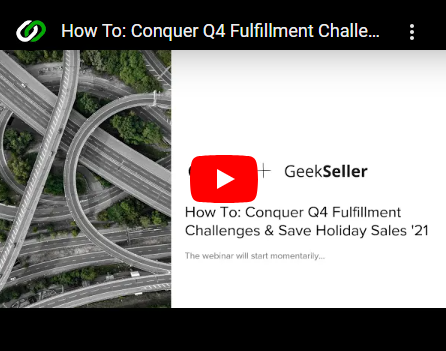
You know the trend by now – Amazon’s competitors are the next big eCommerce market opportunity. You’re putting your products on Walmart, Ebay, Etsy, Google Shopping, and more. You know how to grow on Amazon, so you can just run the same playbook, right?
Not quite – while some things will never change (like customer demand for fast and free shipping), each marketplace has its own unique customer base and tools that can make-or-break sellers.
On top of that, more marketplaces means more operational complexity. You’re scrambling to keep on top of fulfilling orders for multiple marketplaces, and carrier delays, surcharges, and inventory limits will add to the challenge.
How can a seller manage multi-channel fulfillment complexity to capture the huge returns promised by multiple marketplaces? Read on for expert advice from GeekSeller and Cahoot to make sure that you’re maximizing your sales across marketplaces and keeping your fulfillment efficient in the background. First, we’ll explore how to increase eCommerce sales across marketplaces. Then, we’ll provide insights into how fulfillment for those marketplaces is changing and becoming more challenging this holiday season. Finally, we’ll give actionable tips on how to manage those fulfillment challenges.
How to Increase eCommerce Sales Across Marketplaces
James Brazil of GeekSeller notes the incredible results that multi-channel sellers enjoy: “On average, multi-channel marketing and selling increases revenue by 38%, 120%, and 190% with each additional channel”.
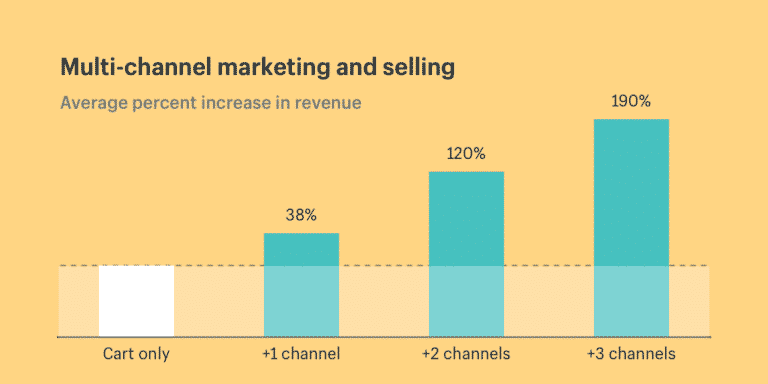
Source: Shopify
Easier said than done, though. With over 1,000 unique eCommerce marketplaces to choose from, sellers have a huge variety of platforms and customers available to them. It’s not just about expanding – you have to do so with a plan that adapts to best practices for each marketplace. Here’s the top tips for the most prominent marketplaces not named “Amazon”.
How to Sell on Walmart – Unique Shipping Templates
Walmart gives sellers more power over their shipping templates than other marketplaces, says James.
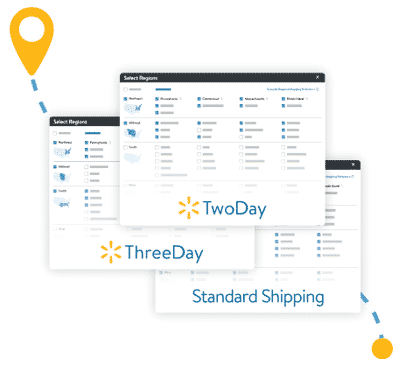
As a seller, you can customize how you ship different products, how you ship to different parts of the country, what carriers you use, and more. Do you sell some products for which customers don’t expect fast and free delivery? Customize that product to always ship ground to maximize your profits. Watch closely to match your delivery promise with your delivery time – customers enjoy and appreciate knowing in advance when their product will be delivered.
How to Sell on Ebay – Excellent Customer Experience
Customer service can feel optional on Amazon – many sellers opt to simply rely on Amazon’s easy and free returns as the totality of their post-sales support.
On Ebay, you don’t have the option to cheap out on service if you want to see good results. The reason is simple: to qualify for the lucrative Top Rated Seller Program, you need to deliver consistently excellent customer experiences. And believe us, you want to qualify for the program, as it comes with three revenue and profit-enhancing benefits:
- Enhanced visibility in search results
- Prominent “Top Rated Plus” seal on listings
- Refund & return label protection
Customer service is the key to qualifying for the program – in fact, for Ebay sellers with >$1,000 in sales in the last 12 months, all of the remaining qualifications are tied to the customer experience. Here’s the full list of qualifications for the Top Rated Seller program:
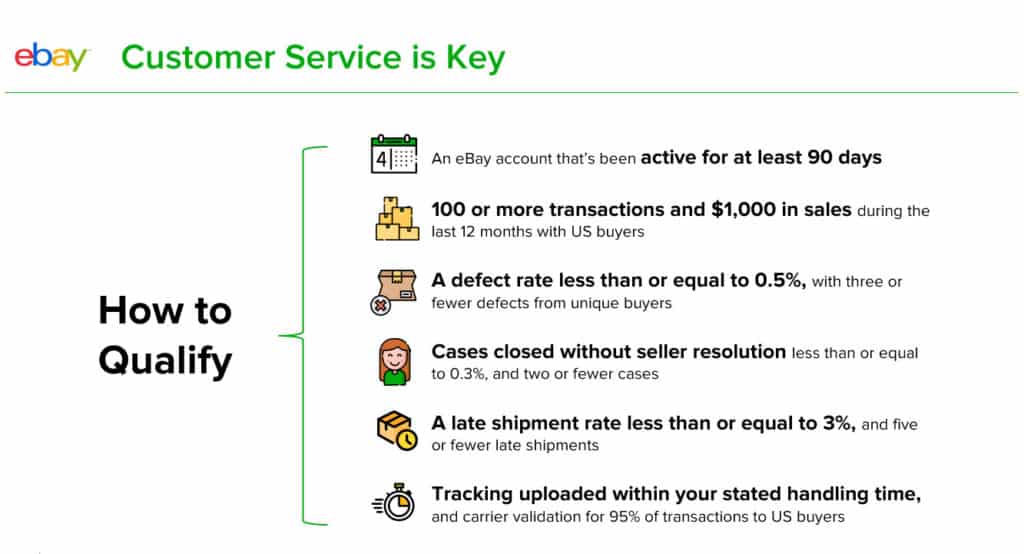
Source: Ebay.com
You’ll need excellent customer service and fulfillment operations to meet these metrics and qualify for the growth-boosting program.
How to Sell on Etsy – Be Unique
Etsy attracts a customer base looking for a more upscale, less transactional experience than Amazon or Walmart. For sellers, this creates two big differences in best practices: first, take beautiful photos (not just clear ones), and second, tell your story.
On Amazon, clear photos of products on white backgrounds are king. Not so on Etsy – customers want to see products situated in environments that help them imagine how they’d use the product. That means that you should put an emphasis on showing people enjoying products and putting the products in curated shots that communicate a target aesthetic. Etsy shoppers aren’t usually looking for the ‘essentials’, and instead are sifting through a large variety of products that they could buy, but don’t necessarily need. Your photos need to help them imagine how your product will improve their life so that they create the need to buy.

Source: Etsy
On top of a different photo strategy, Etsy also gives sellers much more space to tell the story of their brand on their store page, and shoppers are much more likely to actually click and read about the particular brand from which they might purchase. Your story can help further explain how your products help those that buy them improve their lives, and should reinforce the aesthetic created by your photos.
How to Sell on Google Shopping – Boost Your Own Site
Google Shopping is carving out a different niche from these other marketplaces – for starters, it doesn’t charge any merchant fees. Crucially, it provides buying options and includes the ability for you to push shoppers to your own webstore. So, our advice for selling on Google Shopping isn’t actually about selling on Google Shopping: you should use the marketplace to push consumers to your own site, where you can build loyalty and capture revenue without marketplace fees.
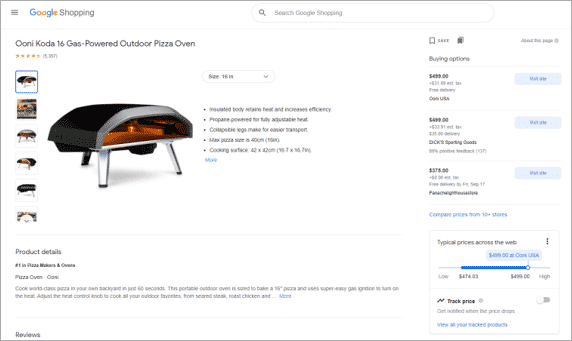
Source: Google Shopping
Look at the ‘Buying options’ section in the top right of the example image above. Do you see what the top option is? It’s for Ooni’s own website. That’s right; Google isn’t trying to capture the transaction themselves, and instead it pushes shoppers to the brand store. Remember that Google Shopping doesn’t charge merchant fees – why wouldn’t you take advantage of this opportunity to win business on your own site? Closing customers on your own site comes with a multitude of advantages, but most importantly, it increases profit and loyalty.
How to Sell on All – Fast and Free eCommerce Order Fulfillment
Of course, some advice is true across all marketplaces, and fast and free eCommerce order fulfillment is as close to a “must have” as they come. A recent McKinsey study reported that over 90% of consumers see 2- to 3-day delivery as the baseline, and 30% expect same-day delivery. You read that right: 2- to 3-day delivery isn’t even a “nice to have” anymore. Consumers simply expect it as the baseline for eCommerce order fulfillment.
With great expectations come great rewards – sellers that do offer fast and free shipping get as many as 10 times more impressions on some marketplaces. Amazon also noted a 50% sales lift for products with a Prime badge, and Walmart similarly reports a 40% GMV lift for products that join their own version of fast and free delivery.
Many sellers still don’t offer fast and free, especially if they’re used to relying on Amazon FBA and are dipping their toes into other marketplaces. Amazon Multi-Channel Fulfillment (MCF) will deliver fast and free for web stores, but it isn’t even an option for the prominent marketplaces mentioned above. If you truly want to boost sales across multiple marketplaces, you’ll need a multi-channel fulfillment strategy that delivers fast and free.
New Q4 Fulfillment Challenges
New fulfillment challenges cropping up this Q4 complicate sellers’ efforts to offer fast and free delivery. This holiday season, sellers face more operational challenges than ever, says Manish Chowdhary, CEO and founder of Cahoot. Parcel carriers face an ever-growing capacity crunch, the holiday selling period is shifting, and Amazon FBA restock limits threaten to cut off growth.
“Shippageddon” – the Carrier Capacity Crunch
The capacity crunch for carriers will have two serious negative effects on sellers – you’re going to pay more, and your shipments will arrive late. Not a good mix.
First, carrier surcharges will eat into profit margins. You can expect to pay more than a dollar extra for each shipment during the holiday period:
- FedEx holiday surcharges 2021:
- $1.50 from 11/1 – 11/28, 12/13 – 1/16
- $3.00 from 11/29 – 12/12
- Additional surcharge for oversize items & high-volume shippers
- UPS holiday surcharges 2021:
- $1.15+ for international and high-volume shippers
- Final numbers for all shippers not yet announced
- USPS holiday surcharges 2021:
- Priority Mail, First Class, and Parcel Select all to incur ~10% extra fees
Unfortunately, there’s no avoiding it – you’ll just have to pay more to get your products to customers. On top of this, shipments will arrive late. On-time delivery dropped to ~75% for the holidays in 2020, and higher volumes will likely drive that rate even lower this year.
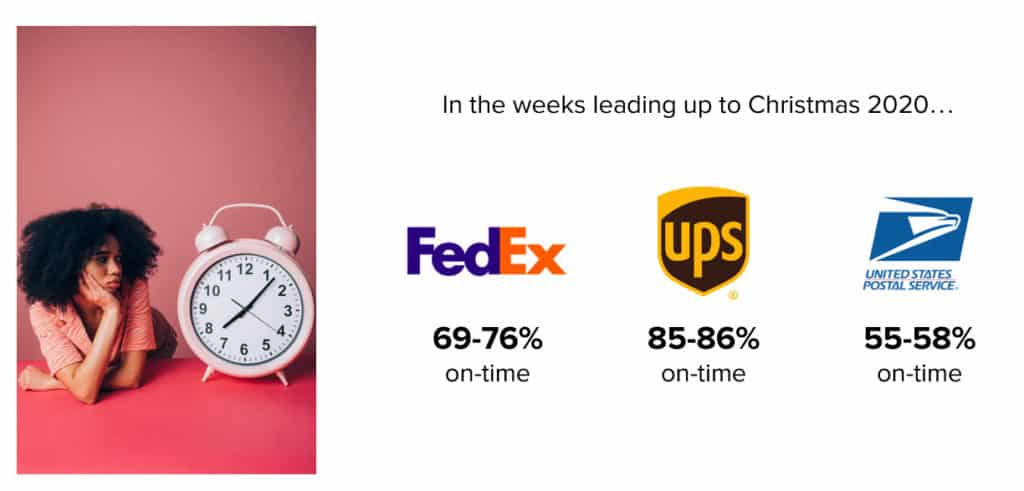
Source: UPS, FedEx, USPS, DigitalCommerce360
In the weeks leading up to Christmas in 2020, USPS and FedEx didn’t even manage to deliver 3/4ths of packages on time. UPS fared better, with 85% on-time delivery, but that number is boosted by the fact that UPS simply did not accept as much parcel volume. As we’ll explore in the next section, the experience with late-arriving gifts is pushing consumers to shop earlier than ever.
Consumers Will Shop Earlier
The days of last-minute sourcing, sales, and success are gone – shoppers have moved up their purchasing, so eCommerce order fulfillment has to move up with it. The National Retail Federation found that 42% of shoppers started their holiday shopping earlier in 2020 than they usually did. They also discovered that over half of consumers start their shopping in early November, and that shoppers have over a quarter of their holiday shopping already complete by then – well before any of the big deals kick in.
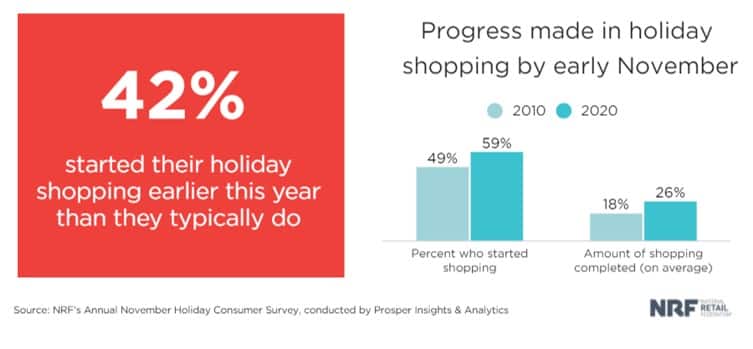
The convenience factor of eCommerce makes it easy to start holiday shopping early. Customers have also learned the hard way that shopping late means late gifting – remember that a full quarter of packages delivered in the run-up to Christmas arrive late, and likely miss the big day altogether.
As more and more shopping shifts online, we expect these trends to continue. Shoppers will continue to treat the entire month of November as their shopping month, and so you need to be ready to sell then – not in mid-December.
Amazon FBA Limits Threaten Sales
Amazon FBA’s inventory limits feel like a black box to sellers. Amazon frequently changes how they calculate the limits, and since eCommerce growth surged in early 2020, they’ve frequently cut sellers’ limits as well.
Amazon FBA sellers were hit with 20-65% drops in their inventory storage limits in April 2021 when Amazon changed from ASIN-level quantity limits to storage-type quantity limits.
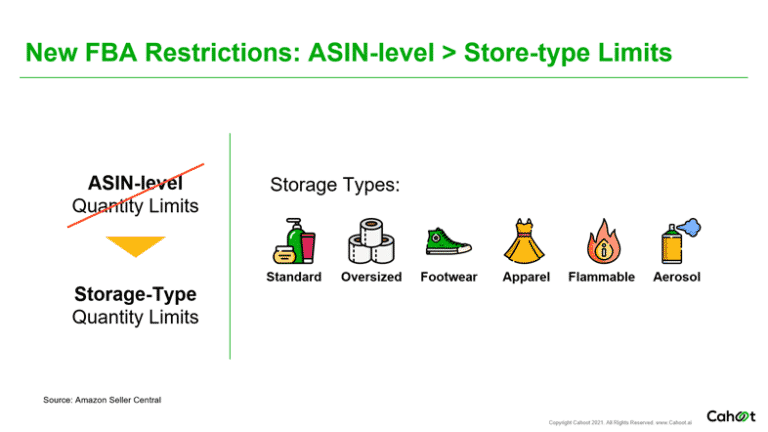
The limit drops haven’t stopped there – Amazon seller groups have buzzed with activity through Q2 and Q3, watching limits go down right before peak. Heavily seasonal sellers see their limits drop repeatedly in their low-volume months, and then are left unable to stock & sell close to their true level of demand when their time comes.
Sellers without a backup plan will see their already low inventory deplete quickly during peak, and slow Amazon FBA receiving could push their hot sellers into out of stock, torpedoing their holiday season. Unfortunately, the troubles don’t stop there; out of stock lowers SKU search rank and lowers inventory limits, creating a death spiral that negatively affects a seller long past the holiday season.
How to Overcome Q4 Fulfillment Challenges
You don’t have to take these challenges lying down. Far from it – if you’re ready with a top-notch eCommerce fulfillment strategy, you can thrive while your competitors struggle.
Be Ready By Early November
It bears repeating: shoppers are buying early and often, so sellers that are ready with products sourced, advertised, and shipping fast and free will grab early returns while their competitors snooze.
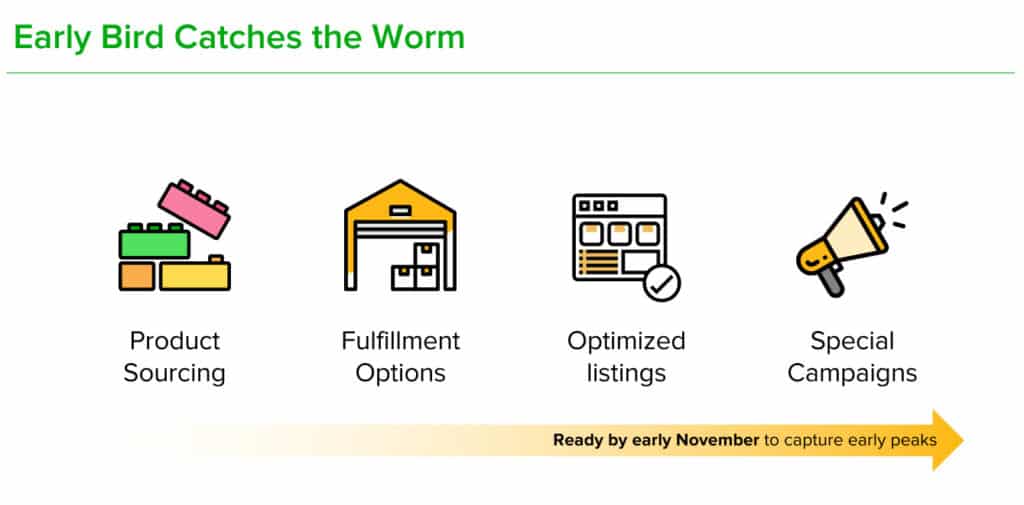
It starts with sourcing early. As Manish relates, “Ports are congested…[and] the cost of containers have gone up as much as 400% for products from China & Vietnam. Be prepared – it’s going to take significantly longer to move those items [to the fulfillment node].” Then once the products get to the United States, LTL freight carriers are overbooked, further delaying the time products take to get online. Moreover, weeks-long delays for Amazon FBA to receive inventory will further push back a SKU’s go-live date even once it gets to them.
All told, holiday sourcing needs to start months before November. Listings need to be ready in October, and then promotions should start in earnest right after Halloween. Don’t miss this new early surge in holiday shopping!
Have a Backup Storage and eCommerce Fulfillment Plan
As we’ve detailed above, providers at all points in the supply chain are overwhelmed, so you need a “Plan B” for every point of the operational chain. Having backup US fulfillment centers is particularly important, as low FBA limits can completely derail a peak selling season before it even gets started.
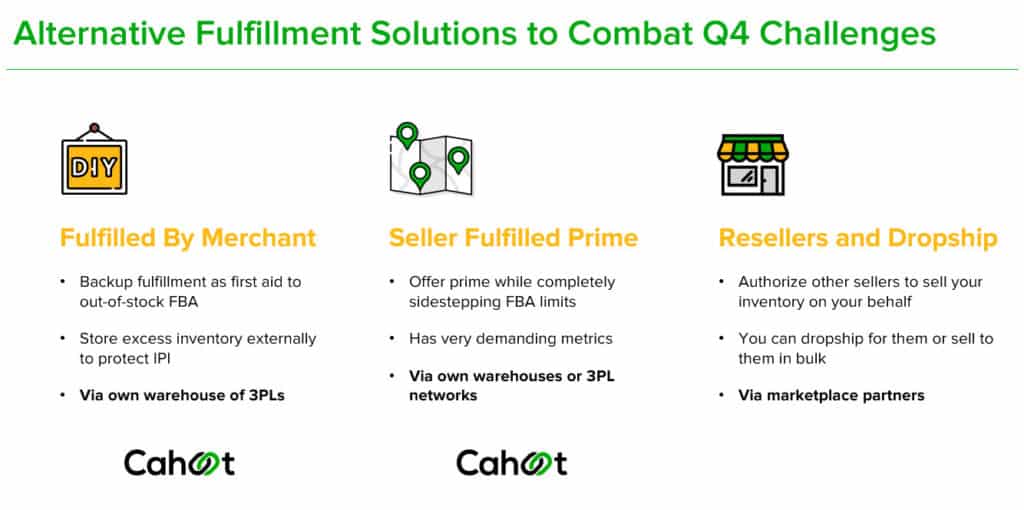
You can take it upon yourself to fulfill your eCommerce orders, but today’s environment for FBM is challenging. Warehouse space has never been more limited or expensive, and there are an incredible 400,000 open job positions for frontline eCommerce order fulfillment workers. On top of that, opening one’s own centers ties up significant capital and is risky – if a seller picks a sub-optimal location, or a location becomes sub-optimal as consumer preferences change, they’re stuck footing the bill.
Another option is to outsource fulfillment to multiple 3PLs. These are generally smaller, independent companies not connected to any specific marketplace. You will have to contract numerous 3PLs to get nationwide 1-day and 2-day coverage. Order routing across disparate 3PLs is complex and labor-intensive, so you may need to invest in expensive fulfillment software to make it more efficient. Fulfillment costs will vary between 3PLs, and not all of them can meet the strict SLAs needed to win the Buy Box on every marketplace, so be sure to use something like a 3PL request for proposal (RFP) template to get an apples to apples comparison.
A modern and affordable alternative to working with multiple 3PLs is to use a peer-to-peer e-commerce order fulfillment network. A P2P network is a collective of highly vetted eCommerce retailers who offer up excess warehouse space and resources to provide high-quality order fulfillment to other merchants. As a result, costs are typically lower than what you get with a traditional 3PL fulfillment company, and service levels are higher. With a P2P network, multi-channel fulfillment with nationwide 1-day and 2-day delivery is the norm. Merchants can use the network solely for outsourced fulfillment, similar to FBA, or they can choose to fulfill orders for other merchants and offset some of their own outsourced fulfillment costs.
Summing Up: Sell More With Excellent Multi-Channel Fulfillment
More marketplaces means more opportunities to win, but also more work, and more that can go wrong. Pay careful attention to best practices for selling across different marketplaces, and then look to services that can reduce operational complexity on the back-end. There are enough Q4 fulfillment challenges as it is – you don’t also want to be wrangling with four different fulfillment strategies for four different marketplaces.
GeekSeller’s multi-channel eCommerce platform automates operational processes for brands across marketplaces, reducing complexity. Every second saved on the back-end is a second that you can spend optimizing your selling approach on Amazon, Walmart, Ebay, Etsy, Google Shopping, and more.
Cahoot’s eCommerce order fulfillment network similarly is an all-in-one solution that seamlessly fulfills orders for any and all sales channels. You won’t even have to think about having multiple marketplaces when it comes to fulfillment; our multi-channel fulfillment solution automatically imports and fulfills orders without any human intervention needed. Cahoot can get merchants ready to sell in as few as two weeks, making the platform an ideal choice for those who need affordable, fast and free shipping on a tight timetable.
Speaker Bios

Manish Chowdhary, Founder & CEO, Cahoot
Manish Chowdhary is the founder and CEO of Cahoot, the world’s first peer-to-peer order fulfillment network where merchants collaborate to increase their sales and margins by offering profitable one-day and two-day free shipping to customers nationwide. Manish has founded multiple industry-leading companies starting from his dorm room at the University of Bridgeport, CT. Manish’s specialties include e-commerce strategy, business methods innovation, supply chain and logistics optimization, and he holds 10 U.S. patents for his inventions. He has been featured in The New York Times, Forbes, Internet Retailer, and many other leading publications. Manish is a 40 Under 40 Competition Winner and holds an Honorary Doctorate, the highest honor from his alma mater, University of Bridgeport, CT.

James Brazil, Enterprise Account Mgr, GeekSeller
James has over a decade of experience in technology and eCommerce. James focuses on helping brands and retailers to expand their online presence, automate processes, and grow their businesses with GeekSeller’s multi-channel eCommerce platform.
